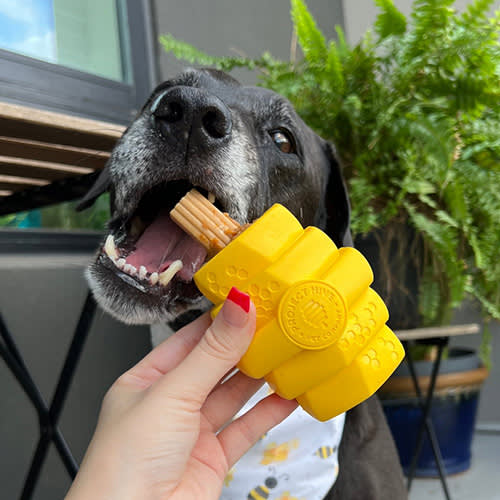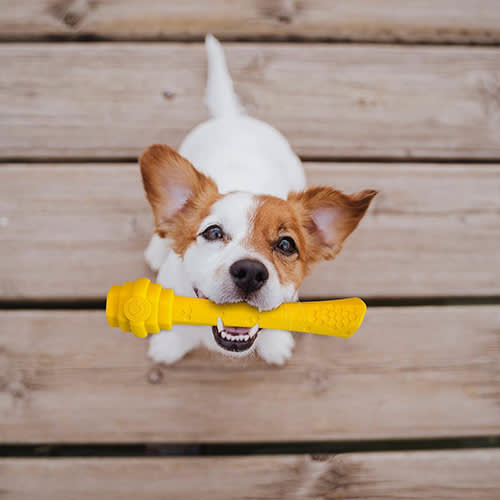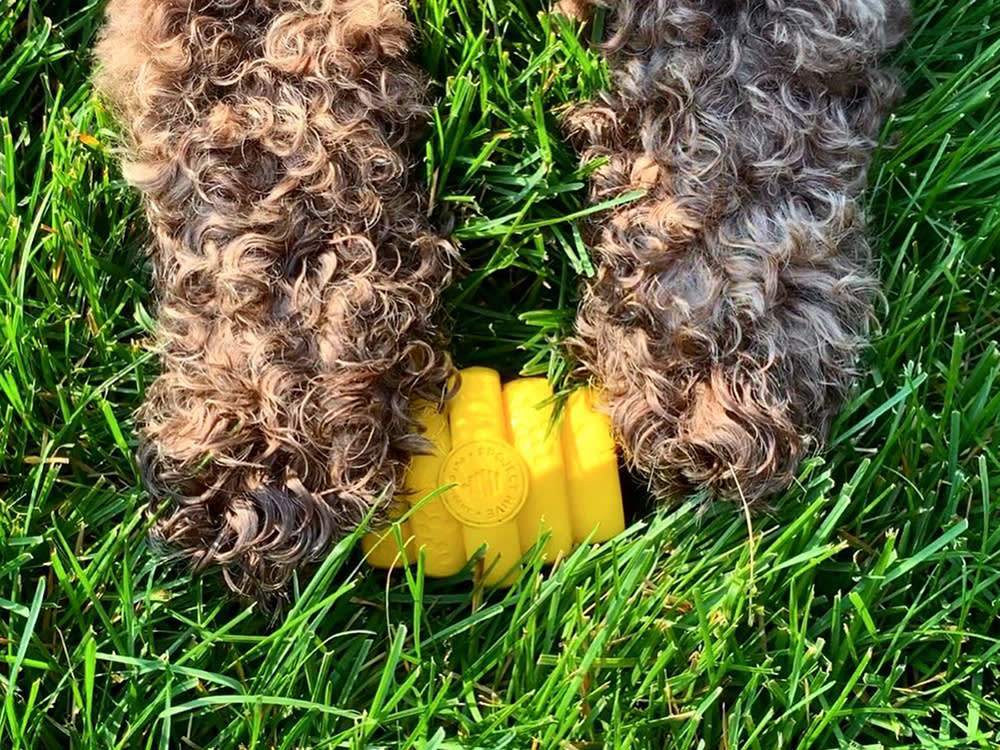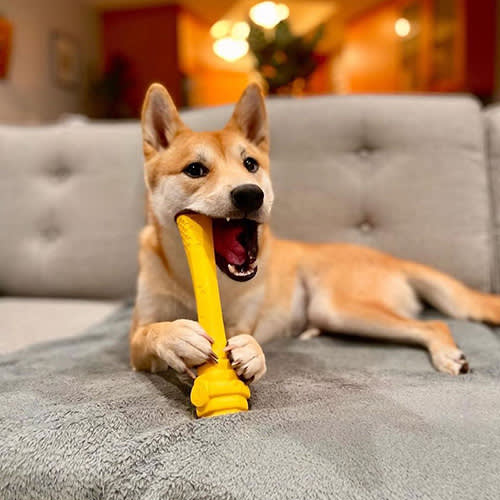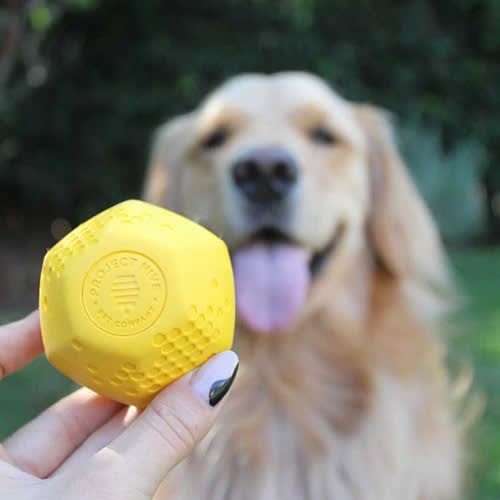The Bee-Inspired Toys Dogs Are Buzzing About
“Saving bees brings more beauty and joy into the world — just like dogs do.”

share article
What do dogs and honeybees have in common? They both star on the homepage of Project Hiveopens in a new tab — a pet company that’s on a mission to save the bees. Melissa Rappaport Schifman and her husband, Jim, started the company in 2021 to give climate-conscious dog owners some tasty new USA-made treats and BPA-free toys. The toys are bright yellow in honeycomb-inspired shapes, and the vegetarian treats and chews are flavored with a touch of honey. Proceeds from each go towards planting wildflower gardens that help keep pollinators buzzing and busy.
The Schifmans also reduce their impact on the planet and all of its critters by keeping their business carbon neutral — meaning they keep tabs on their carbon emissions, get them down as much as possible, and offset the rest through initiatives like tree planting and renewable energy projects. We asked Melissa all about the connection between bees and pups and why everyone should be protecting the world’s pollinators as if our lives depend on them — because they kind of do.
Why bees? What's the connection between dogs and bee conservation?
The mission to save the bees is approachable and relatable. We were motivated by the Earth Watch Institute’s 2008 declaration that bees are the most important species on the planet, as they pollinate about a third of our food. We’ve personally benefited from the work of the bees in our garden, but it goes beyond that. The reasons bee populations are declining relate to broader sustainability issues: industrial monoculture farming, widespread use of insecticides and herbicides, and climate change.
And one of the solutions — planting acres of healthy wildflower habitat — also helps many other species critical to our fragile ecosystem. In the bigger picture, we all live on this one earth that supplies people and pets with clean air, clean water, and food. So to us, the connection is really about embracing life. And saving bees brings more beauty and joy into the world — just like dogs do.
What’s the most interesting thing you’ve learned about bees since starting Project Hive?
The world of bees is so interesting — mostly we just keep learning how much more there is to learn! We knew that bees are responsible for pollinating about one in every three bites of food we eat, but we’ve also learned that about 250,000 types of flowering plants depend on bees for pollination, helping create medicines and cotton clothing. We rely upon the honeybee to not only make honey but also pollinate a wide variety of crops. For example, almonds are 100% reliant upon honeybees for pollination, while pumpkin crops depend more on wild bees. There are over 4,000 native bee species in addition to the honeybee, and they are all important to our food security.
What are some easy ways people can support the bee populations in their area?
If you have a yard, transform part of it into native and adaptive wildflowers! They’re very easy to grow and low maintenance, especially compared with turf grass—which requires mowing, watering, and fertilizing. My favorites include purple coneflowers (echinacea) and black-eyed Susans (rudbeckia). The Pollinator Partnership publishes planting guidesopens in a new tab tailored to specific areas by simply entering your zip code.
If you live in an apartment or cannot grow flowers outside, there are many great nonprofits that help advocate for pollinators. We support The Bee & Butterfly Habitat Fundopens in a new tab directly; other great nonprofits include the Pollinator Partnershipopens in a new tab, the Xerces Societyopens in a new tab, The Nature Conservancyopens in a new tab, and in our hometown, the University of Minnesota Bee Labopens in a new tab.
Do you have a dog? Do they have a favorite Project Hive product?
Ah, the great irony is that we have two cats! I’m allergic to most dogs, so we play with our team’s dogs, Kola and Clementine. Right now, their favorite toys are the Hive Fetch Stickopens in a new tab and the Small Hive Chew Toyopens in a new tab. For treats, they are loving our small Hive Chew Sticksopens in a new tab, because they fit snugly into the toys’ cavities. The compatibility of those toys and treats is perfect for interactive play! (Our family likes the Hive Discopens in a new tab, since it’s a better flyer than most frisbees!)
What’s next for Project Hive?
We’re working towards becoming B Corp Certified. We’re really excited about our bundle boxesopens in a new tab for sale on Chewy.comopens in a new tab — our first one is to celebrate Earth Day, and pet parents can realize big savings! We’re also thrilled to be launching in a few hundred Petcoopens in a new tab stores in May. For future launches, we’ve got several product ideas in development, and we always try to maintain the integrity of our brand—to do what’s best for pets, people, and the planet. As we like to say, “Let’s make our Planet Thrive — one happy dog and countless bees at a time!”
* The interview has been edited for brevity and clarity.

Emma Loewe
Emma is a writer, editor, and environmentalist based in New York City. She is the senior sustainability editor at mindbodygreen, the author of Return To Nature: The New Science of How Natural Landscapes Restore Us (April 2022), and the co-author of The Spirit Almanac: A Modern Guide To Ancient Self-Care. While she doesn’t have any pets of her own, she is a loving dog aunt to Pip the pup.
